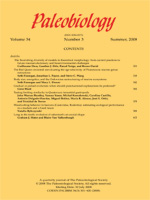Phylogenies provide a rich source of information that should be exploited in designing quantitative hypothesis tests in paleobiological contexts. Viewing such data analysis problems through the prism of phylogenetically structured comparisons can help add realism and depth to paleobiological data-analysis strategies. Two examples of the importance of adopting a phylogenetic perspective are discussed. In the first example, a phylogenetic-comparative approach is used to test correlations between ecological, morphological, and biological characteristics of planktonic foraminifera. Results suggest that the presence of spines and photosynthetic symbionts in Neogene–Recent species are not adaptations to living in shallow-intermediate planktonic depth habitats. In the second, a phylogenetic-comparative approach is used to reveal the presence of morphological correlations with locomotor function in a mammalian carnivore data set. Paleontologists can play an active role in improving comparative data analyses by (1) helping to develop improved phylogenies, especially those that provide better estimates of branch lengths, and (2) helping to resolve a number of outstanding issues surround the question of ancestral character-state specification.
How to translate text using browser tools
1 June 2001
The role of phylogeny in quantitative paleobiological data analysis
Norman MacLeod
ACCESS THE FULL ARTICLE





